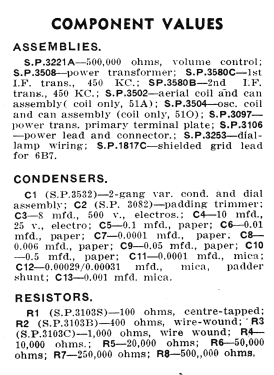- País
- Australia
- Fabricante / Marca
- Standard Telephones and Cables Pty, Ltd (STC), Sydney
- Año
- 1936
- Categoría
- Radio - o Sintonizador pasado WW2
- Radiomuseum.org ID
- 335138
Haga clic en la miniatura esquemática para solicitarlo como documento gratuito.
- Numero de valvulas
- 5
- Principio principal
- Superheterodino en general; ZF/IF 450 kHz; 2 Etapas de AF
- Número de circuitos sintonía
- 6 Circuíto(s) AM
- Gama de ondas
- OM (onda media) solamente
- Tensión de funcionamiento
- Red: Corriente alterna (CA, Inglés = AC) / 200; 250 Volt
- Altavoz
- Altavoz electrodinámico (bobina de campo) / Ø 8 inch = 20.3 cm
- Material
- Madera
- de Radiomuseum.org
- Modelo: 511A Ch= 51A - Standard Telephones and Cables
- Forma
- Consola en general
- Anotaciones
-
STC Models 511A & 514A are 5-valve Console type receivers designed for broadcast coverage and operation from 200-250 volts AC mains.
Apart from the cabinet style, these two receivers are identical & employ a chassis known as type “51A”. This chassis is fitted with two controls, tuning & volume & uses an 8-inch, 2,500Ω field, loudspeaker.
The arrangement of this receiver is fairly straightforward, but there are one or two points that should be carefully noted.
The first of these is that the aerial coil is connected directly to the low-potential end of the 6A7 grid coil; this means that the aerial itself is “floating” at AVC potential & consequentially, any leakage from aerial to earth will reduce the AVC & may in a severe case actually stop the AVC system functioning.The next point of interest is provided by a shunt-fed oscillator circuit; this is mentioned because it differs so markedly from the system used in chassis type “51B”.
Another interesting feature will be found in the omission of a by-pass condenser across the output valve cathode resistor; the effect of this is to introduce a percentage of degeneration (“inverse feedback”) & so reduce distortion.
Finally, very important attention should be paid to the position of the power cord connector (SP 3106). This fits into the terminal plate assembly (SP 3097) & its position determines whether the receiver is adjusted for low or high mains voltage operation.
The power cord connector is labeled, and the correct position is when the mains voltage corresponds to the marking facing upwards.
Radio Trade Annual 1939, Page 323.
- Documentación / Esquemas (1)
- Radio Trade Annual of Australia (6th Edition 1938.)
- Documentación / Esquemas (2)
- Mingay's "Radio Diagram & I.F. Index
- Autor
- Modelo creado por Martin Kent. Ver en "Modificar Ficha" los participantes posteriores.
- Otros modelos
-
Donde encontrará 616 modelos, 272 con imágenes y 306 con esquemas.
Ir al listado general de Standard Telephones and Cables Pty, Ltd (STC), Sydney


